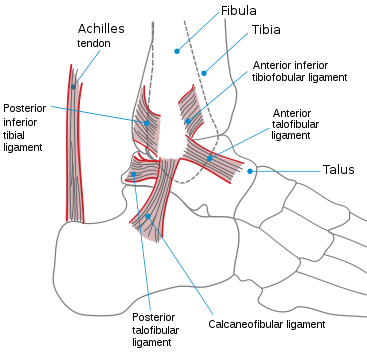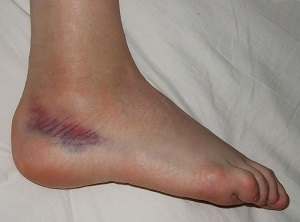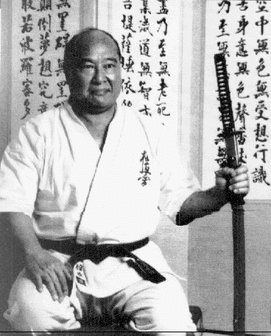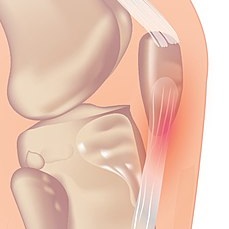Ankle sprains are one of the most common joint injuries, with almost everyone suffering from a minor strain or sprain at some point during their lives. As a result, learning how to treat a sprained ankle is wise whether you’re treating yourself, a family member, or someone in your care.

Source: Wiki Commons
I’ve been struggling with weak ankles since I was a child. In my situation, spraining my ankles, particularly my left foot, was a never-ending story. Every year, I sprained my ankles 2-4 times due to numerous movements in my sport. The ligaments and tendons become weak and stretchy because of this. Training the weak ankles was ineffective and it did not produce any considerable results.
A sprained ankle occurs when your ankle is rolled, twisted, or turned in an unusual way. As a result, the tight bands of tissue (ligaments) that hold your ankle bones together may be stretched or ripped. When your ankle is stretched beyond its normal range of motion, one or more of its ligaments may strain, partially tear, or totally tear, causing a sprain. Sprained ankles are most usually caused by injuries to the ligaments on the outside of the ankle.
The symptoms of a sprained ankle vary depending on the severity of the injury. Swelling and bruising, discomfort in the affected foot, ankle instability, and other symptoms may occur.
Ankle sprains can have many different causes:
- Your ankle may twist because of a fall
- Jumping or spinning and landing on your foot in an awkward position
- You can sprain your ankle when walking on an uneven surface.
- Another person steps or landings on your foot during a sporting game.
Please notice that this blog post isn’t intended to diagnose you. If you’ve injured your ankle, make sure to contact a doctor or a physical therapist to determine the degree of your injury. Failure to detect all possible injuries to your ankle correctly could result in a longer recovery time and greater damage.
Instant treatment of sprained ankle
The treatment for a sprained ankle is determined by the severity of the injury. Although self-care and over-the-counter pain medicines may be sufficient, a medical checkup may be necessary to determine the severity of your ankle sprain and the appropriate treatment.
When you ankle has been sprained, take action as soon as possible. Do some modest range of motion exercises right after your injury to help enhance your functional outcomes. This may also reduce the amount of time it takes you to get back to the game.
Rest is necessary to avoid aggravating the injured joint. Ice might help with pain and swelling relief. Compression serves to stabilize the joint, minimize swelling, and provide some protection during the first 24–48 hours after an injury. Propping your foot up on a chair during the day can help relieve discomfort and swelling in your ankle. By not applying the correct treatment, the healing process will take much longer time.
Use the R.I.C.E. approach for the first two or three days after an ankle injury:
- Rest. It is best to avoid activities that cause pain, edema, or discomfort.
- Ice. As soon as you wake up, use an ice pack or an ice slush bath for 15 to 20 minutes, then repeat every two to three hours while awake. If you have vascular disease, diabetes, or impaired sensation, consult your doctor before using ice.
- Compression. Using an elastic bandage, compress the ankle until the swelling goes down. Circulation can be obstructed by wrapping too tightly. Begin wrapping towards the far end of your body, away from your heart.
- Elevation. To reduce swelling, elevate your ankle above the level of your heart, especially at night.
At night, rest and elevation, in particular, are critical components of R.I.C.E. Rest is essential to recovery in general, and staying off your feet for several hours at night is ideal. Keeping a pillow or cushion under your foot can also help with recuperation. This aids in elevating the damaged joint above the heart.
When it comes to wrapping a sprained ankle overnight, there are a few different approaches. Daytime joint support and protection is usually provided with sprain braces and supports. An elastic bandage, on the other hand, should help if you’re in a lot of pain and want to wrap your ankle at night for some relief. Some specialists recommend leaving the bandage on at night, but only if it’s very loose.
Personally, I have experienced good result when applying the R.I.C.E principles. I often forgot to apply compression, but it turned out that it is vital for reducing the swelling.
If your ankle doesn’t feel better after a few days of home care, consult your doctor for advice and to ensure you aren’t suffering from a more serious injury, such as a tear or fracture.
To avoid the inevitable cycle of recurring ankle problems, it’s vital to recover properly from an ankle sprain.
Prevention of reoccurring injuries
Following these tips will help you avoid a sprained ankle or a repeat sprain:
- You should warm up before participating in sports.
- Be cautious when walking, running, or working on an uneven surface.
- Use an ankle support brace or tape on a weak or previously injured ankle.
- Wear comfy shoes that are appropriate for your activities.
- Avoid wearing high-heeled shoes if at all feasible.
- It is not a good idea to engage in sports or activities for which you are unprepared.
- Muscle flexibility and strength should be maintained.
- Balance exercises, as well as stability training, should be undertaken.
Even with strong muscles, optimal biomechanics, and excellent conditioning, ankle sprains are still possible, and in some situations, very likely. After spraining your ankle, the best way to minimize recurrent ankle injuries and subsequent ligament damage is to wear a preventative ankle brace that is comfortable to wear and allows full range of motion.
I have tried many different types of elastic braces to prevent injuries. None of them worked. They are too elastic give minimum or no considerable support. After years of trying and filing I found one type of braces that had very positive effect: lace-up braces. Lace-up ankle braces are normally not recommended, because they reduce strength, performance, and range of motion. However, lace-up ankle braces have a good preventive effect when you experience reoccurring injuries and haven’t found any other solutions.
I’ve used the McDavid 195R lace-up brace for more than 10 years, and during this period I haven’t experienced any sprained ankles. Remember, I went from 2-4 injuries a year to none. It was just amazing.
For me the McDavid braces have been the solution to my everlasting problem, and I recommend it to anyone who experience reoccurring injuries. I believe that the main benefits of a lace-up brace are that the vertical bands simulates the natural ligaments and gives extra good support.



